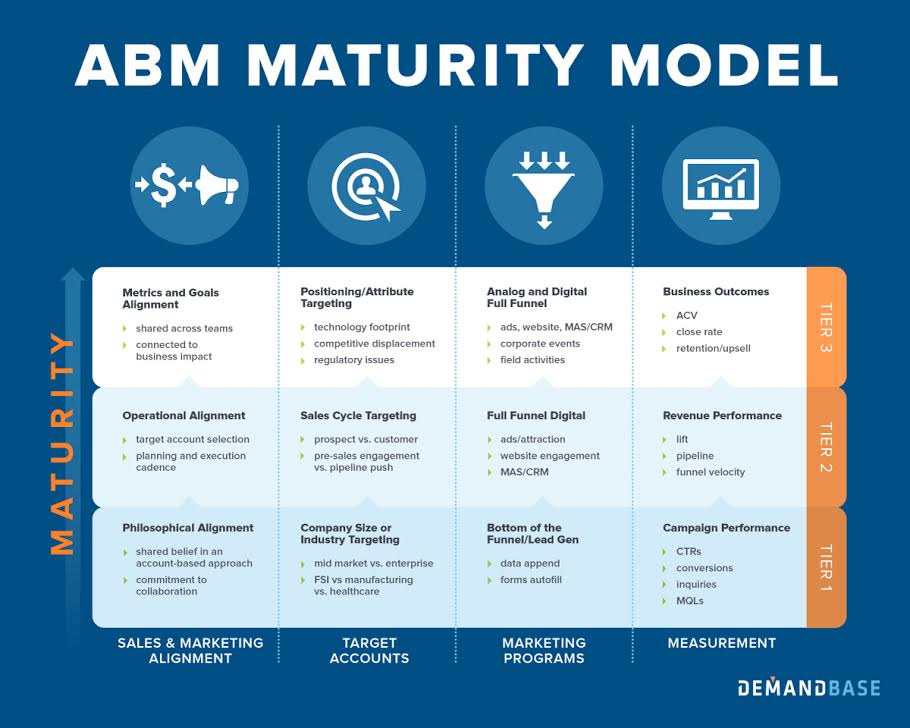Quick Guide for ABM Maturity Levels

Quick guide for ABM Maturity Levels:
The best aspect of ABM is its business outcome. Incredibly, 60% of companies that use ABM saw a revenue increase of at least 10% within 12 months, while 1 in 5 companies experienced a revenue increase of 30% or more. (According to superoffice.)
ABM is of one the most lucrative marketing tactic. The reason, ABM gives a higher return than any other digital marketing tactics used, other sub-factors include:
- Sales and Marketing alignment.
- Complete prospect overview through TAL.
- Implementation and media planning through strategy.
- Measurement of investment.
Where the statistic lures us to implement ABM program there is a catch - The outcome of the ABM program is depending on the maturity level of it and the implementation according to it.
Successful marketers use ABM Maturity model for better media planning and targeting. The successful modelling of ABM Maturity gives an overview of each stage and the buyer journey.
If you know what is ABM then you can jump to the Maturity level related details further down.
"Account-based marketing, also known as key account marketing, is a strategic approach to business marketing based on account and profile in which an organization communicates with individual customer accounts as markets of one."
As compared to another marketing strategy the ABM marketing strategy is a direct approach marketing strategy because in that we have to target a particular company based on their profile and market size.
The success of the ABM program depends on how you identify various aspects of it and map the maturity level of operation, content delivering and metrics.
ABM - Maturity Levels:
We have seen that Implementing ABM takes time and efforts if you are trying it for the first time. We learned from many ABM campaigns and also working closely with various brands. It is recommended to start with one ABM campaign with one product or service as a pilot. Then with continuous Improvement approach, you can scale the ABM implementation at reach various maturity levels.
Based on our experience and research listing below 4 key aspects of ABM and Maturity levels in them.
1. Sales and Marketing alignment:
The nature of ABM Marketing strategy allows us to form a better alignment than any other marketing strategy. ABM knows the accounts and mainly works toward closing it covering the maximum TAL is stack.
The sales team also works on the same principle - to close accounts and have higher ROI. This nature of marketing enables sales and marketing alignment between departments.
This is about the cultural and philosophical alignment when marketing and sales work at operational and goal alignment, it ensures that the leads marketers push to sale do not bounce. The success of sales becomes the success of marketing and vice versa.
A quick overview of the level of maturity of the ABM program with sales alignment.
Level 1: Cultural collaboration
- Communicate often.
- Work on the same belief.
- Commitment to alignment.
Level 2: Operational Collaboration
- Media planning.
- Content Management.
- Lead management.
Level 3: Goal alignment.
- Share goals.
- Measure business outcome with pre-defined metrics.
2. The readiness of TAL.
In ABM Marketing strategy design - the common challenge every marketer's face is to create accurate TAL. In today's data-driven world, there are tools we can leverage to build tentative TAL using intent data. Besides, intent data we could leverage the in-house data sources to build and curate TAL.
While building TAL - we need to think of demographics and technographic term. The TAL should be mapped according to its effectiveness for various stage and channel.
The levels are:
Level 1: Demographics coverage.
- Account size.
- Internal hierarchy insights.
Level 2: Funnel Coverage
- The stage of funnel DMU (Decision Making Unit) is.
- The personalization of content according to the funnel stage.
Level 3: Technographics and digital footprint.
- Behaviour signals
- Buying readiness through intent signals.
- Multi-channel targeting.
3. Media planning and content personalization:
In ABM campaign it is important to leverage multi-channel and personalised targeted approach to push the lead down to funnel. Media planning is needed to be done according to prospect behaviour.
The marketing performance varies with the stage the program is. The content and channel needed to be personalised according to the marketing program requirements.
Level 1: ToFu targeting and lead generation
- ToFu leads
- Lead management
- Quality checks
Level 2: Multi-channel enablement
- Intent mapping
- Channel consideration.
- Content personalization.
Level 3: Cross-channel engagement
- Events
- Demos
How well you could penetrate in given TAL defines the account you covered with your personalised campaign program. The account coverage isn't measured with mere numbers but the impact you made on accounts.
The metrics should be pre-defined and aligned with the sales team. The criteria of MQLs and SQLs should also be accepted by both parties (sales and marketing) to measure the success of ABM effectively.
Level 1: Engagement metrics
- The open rate of email
- CTR
- Enquiries
- MQLs
Level 2: Revenue performance.
- Pipeline acceleration
- Account coverage
- SQLs
Level 3: Sales/business performance
- Close rate
- Advocacy marketing
- ROI
Conclusion:
ABM Maturity modelling helps marketers to measure the performance of campaigns. It helps to optimise campaigns and personalise the content. The sales and marketing team should be informed and aligned on a single model - to operate more effectively.
References: